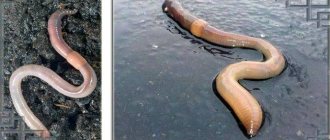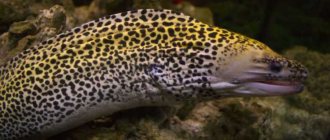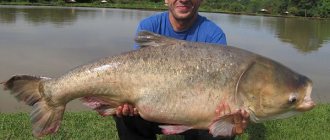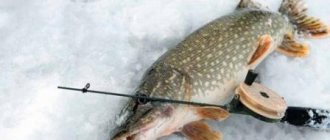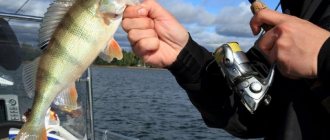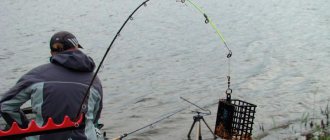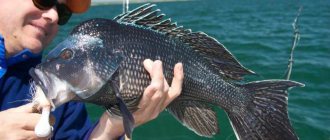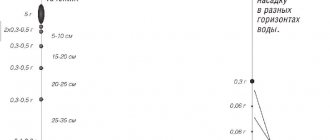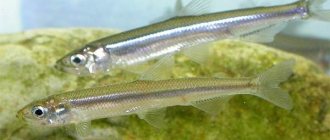maggot bait
A maggot is the larva of a blue, green or black blowfly. This is a white or cream-colored worm, very mobile. Excellent bait for catching bream, roach, sabrefish, bleak and other fish. The maggot holds well on the hook; several fish can be caught with one larva.
They bait maggots when fishing for bream and sabrefish, 3-5 pieces each, piercing them across near the thick end. The sting is covered with the last maggot, baiting it lengthwise, piercing it at the thin end - then it will not come off the hook. The maggots must remain alive and mobile. Bait carefully, without pressing too hard, so that the maggot does not leak out. The hook should be sharp, with a medium-length shank. When catching sabrefish on a bottom fishing rod with a rubber shock absorber (elastic band), the hook must have a long shank. When catching fish, such as bleak or other small ones, maggots are baited lengthwise, one at a time. To better detect the fish, the maggot is pierced through, and then the sting is pulled back, hiding it in the body of the maggot.
The easiest way is to buy maggots for bait at a fishing store. We sell maggots colored with food coloring - red, green, black, yellow. If desired, you can tint the maggots yourself with Easter egg paint. The dye tablet is crushed, two drops of water are added and added to the maggots. It is useful to use black maggots if you catch large fish in places where there are a lot of bleaks. The bleak does not notice the dark bait. Flavored maggots are also sold - with the smell of vanilla, anise, dill, etc.
If you decide to breed maggots yourself, then it is better to do it in the following way. On a small piece of meat or fish you get a clutch of fly eggs in the open air. These eggs are then scraped off and placed in a tightly sealed jar of curd. Cottage cheese produces maggots that are white, strong, and mobile. After five to six days, maggots grow to their optimal size (5-10 millimeters). They are transferred to a jar with a mixture of sawdust and flour, and stored in the refrigerator.
Another way to breed maggots . They take a piece of meat (preferably liver or lung) and make many cuts on it. Instead of meat, you can take fish with a cut belly. The meat is placed in a tin can with sawdust and placed outside in the shade. When the flies lay their eggs, close the jar with a rag and tie it tightly. As they grow, the maggots are fed.
For long-term storage, maggots can be frozen in the refrigerator. After thawing at room temperature (never on a radiator), the maggots come to life.
Anglers also fish with boiled maggots. Place maggots into a tin can of boiling water for two to three minutes. At the same time, the maggots are reduced in size by half, become transparent and sink to the bottom. Store this bait in a jar with damp cotton wool or gauze.
When storing maggots, you need to remember that maggots are very mobile, and if they scatter, they appear everywhere - all over your backpack, boat, in food, clothes. Therefore, they need to be kept in tightly sealed jars. There is no need to make holes in the jar; maggots can get by with an insignificant amount of oxygen, and can crawl into the smallest hole.
What types of bait are there? Part 3. About worms and larvae
Go to the previous part of the article.
White earthworm. It is not found in sand, very rocky or hard clay soil, but is distributed everywhere. Meadows and vegetable gardens, holes and hollows, coastal hummocks and sediments - this is just a small list of places where it can be collected in large quantities.
This worm has a lot of shades, but the predominant color is off-white. This is a sedentary creature that sits quite tightly on the hook, and when it is baited on the hook, it stretches greatly. Mostly ide is caught using white earthworms in the spring and closer to winter.
White earthworm Photo: Source
Bloodworm. Very good bait. This worm is nothing more than the larva of a long-lasting mosquito (bell-bellied mosquito, jerk-mosquito). Its color is bright red, ruby. The bloodworm can be up to a couple and a half centimeters in length, and reach two millimeters in diameter.
You can look for bloodworms in river backwaters, where there are silt deposits, but it is better in the standing waters of ponds and lakes, sometimes near sewers. The process is painstaking, but not complicated. The equipment is simple. Using a regular bucket or scoop, take the bottom soil and wash it on a sieve with cells of approximately 1×1 mm. After washing, a small amount of debris and bloodworms will remain on the sieve. They usually wash it in reserve due to the difficulty of storage. And this needs to be done from winter until the end of May, until the mosquitoes hatch from the larvae.
Bloodworm Photo: Depositphotos
Young fish such as carp, crucian carp, bream, roach, tench actively feed on bloodworms... In winter, all the fish that do not stop feeding are caught with it. But in the summer it is almost impossible to wash bloodworms suitable for fishing. Although, as an option, you can buy it in pet stores - they always have it there as aquarium food.
It is usually difficult to preserve washed bloodworms, especially without knowing how. In order to preserve it for fishing as much as possible and in a living form, it should be stored in a foam box, where the bait can be placed along with white moss or sleeping tea.
Typically, a temperature of about 5 degrees Celsius is permissible for storing bloodworms (a household refrigerator is quite suitable). But this is in everyday life. If you need to save live bloodworms directly while fishing, then you need to look for a spring, and in its absence, use the water of the reservoir itself.
To do this, you need to place the bloodworm from the box in a nylon stocking in the evening and lower the bundle into water overnight. In the morning, the bloodworms are taken out of the water, dried on newspaper for about fifteen minutes and placed again in a foam box.
Photo: Depositphotos
If there is an abundance of bloodworms in the fishing place, then you can get it there, but not in the method described above, but in a slightly simplified way. To do this, you need to take a bucket or other suitable container. Scoop up the sludge along with water and place it at some distance from the fire. When the temperature in the bucket begins to rise slightly, the bloodworm will rush to the surface of the water, and all you have to do is collect it, rinse it and save it.
Green worm. It is not very popular due to the difficulty of obtaining it. It is found in floodplain meadows, where various debris lingers during flood periods. The color of such a worm is gray-green. It holds the hook well and belongs to the category of “delicacy” baits for fish.
Subleaf. This type of worm is found quite often in meadows under old cow dung pats, in piles of rotted leaves, or under overturned turf. It is usually red in color with a slightly iridescent hue close to purple and an off-white tail. This is a weak worm that breaks very easily and because of this is completely unsuitable for baiting a hook in a bunch. It simply jumps off the hook, so it needs to be hooked one at a time. I don’t know about anyone, but I personally take them as a last resort, on the way to the fishing spot.
The topic of bait is not closed. To be continued…
Tags: fishing, fishing, fish, bait, fish bait, fisherman
Bloodworm
A bloodworm is the larva of a pusher mosquito (dolgunets, bells, and jerks). Found at the bottom of lakes and backwaters in silt. The bloodworm is ruby-colored, 10-15 millimeters long. The bloodworm lives in the bottom silt of lakes, reservoirs and backwaters.
The vast majority of peaceful fish feed on bloodworms. They use bloodworms to catch roach, bream, bleak, crucian carp, ruffe, etc. Bloodworms are considered a traditional bait for winter fishing. burdock shows good results in winter fishing .
planting bloodworms
They bait one bloodworm with a “stocking”, sticking it into the second segment of the body after the black head, being careful not to crush it. Several bloodworms are baited with a brush.
It is convenient to bait a bunch of bloodworms using a small device. The cap from a ballpoint pen is cut off so that a cone with a hole diameter of about 5 millimeters remains. Pieces of nipple elastic are put on this cone. Bloodworms (2-5 pieces) are inserted halfway into the hole, and the ring is pulled off the cone. The bloodworms are tied together with a “belt”. It is best to prepare bloodworms at home the day before fishing.
extraction and preparation of bloodworms
Bloodworms are sold in fishing stores. There are large bloodworms for bait and small groundbait bloodworms on sale. Small bloodworms are also sold in pet stores as food for aquarium fish.
Bloodworms are obtained from the bottom of reservoirs not only in winter, but also in summer. In winter, an ice hole about 1 × 1 meter in size is cut so that the scoop can be turned in different directions. Using a metal mesh scoop with a long handle (or simply a bucket tied to a rope), silt is scooped from the bottom and washed on the surface. Then the scoop is raised, the water is allowed to drain, and it is immersed again. The floating bloodworms are collected with a small net.
There is another device for preparing bloodworms . A U-shaped frame 50x50 centimeters is made from a steel bar. Thick fishing line strings are tied across it at intervals of 1 centimeter. The frame is attached to a long handle. The device is lowered into the hole and the frame is passed through the silt. The bloodworm hangs on the strings and is simply shaken off onto the film.
You can get bloodworms directly while fishing by going into the water and collecting mud in gauze. The sludge is washed and the bloodworms are taken out.
Methods for placing a worm on a hook
When fishing, you should always remember that the bait should look beautiful. If it consists of living components, it should move. The same applies to worms. We put nimble and nimble worms on the hook. If they hang like a whip, the fish will probably ignore them.
Naturally, the hook must be sharp. With its help it is easy to make neat punctures, and we will not damage the skin. Remember that the hook size must correspond to the hook number. That is, you should not put a large white worm on a small hook.
You can plant the worm through the middle, through the beginning with a stocking, a ring, piercing it in several places. If we catch medium and small fish, then you can attach half a large worm or a whole medium sized one. A bunch of 4-5 medium-sized worms is placed on the bream. The largest earthfish are hooked onto catfish, and also in bunches. In the picture we see different options for attaching worms.
When fishing, after reeling in the gear, we look at what the worm looks like. With a capricious bite, it is very important that it is always mobile, juicy and attractive. Therefore, if we see a shabby crawler or dung beetle on the hook that has lost its presentation, then we change it to another, more presentable one.
It happens that for some reason the crucian carp takes not the whole worm, but its pieces. They are put on a hook with a long shank. In some situations, crucian carp takes so actively that it is even caught on scraps of a worm. On such fishing trips, you can simply cut the worm into pieces and attach them as you use them.
Let's highlight combinations of worms with other baits. Combinations of worms with bloodworms, maggots, corn, pearl barley, and wheat are considered catchable.
bloodworm storage
Bloodworms should be stored in the refrigerator in water. If you plan to store it for a long time (up to two months), then the container should be half filled with sludge. The water needs to be changed periodically. The bloodworm lives in a box between layers of damp gauze for up to two weeks.
For fishing, bloodworms are taken in a foam or plastic box, first dried on paper - then it does not stick together and does not turn sour. The bloodworms are kept warm - in the bosom, in the inner pocket or in the sleeve.
Convenient containers for storing bloodworms while fishing can sometimes be found in fishing stores. This is a streamlined plastic box, on one side tied to an elastic band with a strap that fits over the shoulder, and on the other side a plastic boss is tied to a short leash. The moth is located in the sleeve of a fishing jacket. When you need to get a bloodworm, the fisherman pulls the boss and takes out the bloodworm. The moth is pulled back with an elastic band.
caddis bait
The caddisfly ( shitik , crowberry ) is an insect larva similar to a small butterfly, living in water in a tube house made of pieces of plants, sand, and sticks. The caddisfly has a black head and legs and a white or greenish body.
The caddisfly is a common food for many fish; they treat it without “suspicion” and peck without fear. It is used to catch roach, bream, ide, chub and other white fish. Caddis flies are used in both summer and winter fishing.
Before turning into an adult insect, caddis flies spend a year under water, then pupate, and after some time butterflies emerge from their houses. During the day they sit on coastal bushes and grass, and in the evening they circle over the pond. On caddisfly - butterfly they catch ide, chub, saberfish, asp, trout and other riding fish. They are collected early in the morning in the coastal grass.
Caddis flies are caught in streams, small channels under stones, snags, by hand or using a net. In winter, caddisfly is prepared as follows. Rub a damp washcloth with flour or tie a cut fish to it. They tie up the load and lower it on a fishing line to the bottom. Caddis flies, attracted by the smell of flour or fish, get caught on the washcloth. After 15 minutes, the trap is removed and the crowded caddisflies are removed.
Caddis flies are also sold in fishing stores.
Caddis flies are stored in the same way as bloodworms - in the refrigerator in water or damp gauze, and kept warm during winter fishing. During long-term storage, shitika is fed with bloodworms.
The caddis hook is baited with a “stocking” under the head so that the hook is completely closed.
How to Preserve Worms for Fishing
06 September 2013 |
Lyoshik It’s no secret that successful fishing, including fishing on Akhtuba in Three Rivers, always depends on several factors: correctly selected gear and fishing technique, the vagaries of the weather, the bait used and the experience of the fisherman in determining the fishing location at a particular moment. Many will agree that choosing the right bait, given other favorable conditions, will probably be the decisive factor influencing the fish’s bite.
Therefore, it is so important to choose the right bait before fishing and save it. Lures for fishing are divided into artificial (mainly for predators) and natural , which in turn are divided into baits of plant origin - baits (mainly for catching peaceful fish) and animal origin - bait (almost all types of fish are caught with them).
Of course, the most versatile bait is worms. They catch all types of peaceful fish, including large bream, carp, crucian carp, chub, roach, sabrefish, etc. (except grass carp and
silver carp), as well as small specimens of predators: perch, pike perch, bersh and catfish. There are a huge number of species of annelids and they live in a wide variety of environments around the world: from the Arctic to the depths of the sea and the tropical jungle, but for fishing in our region, mainly several species are used: red dung worm, earthworm, forest worm (subleaf worm) , green worm and, less commonly used, crawl and iron ore.
Types of worms used for fishing.
1. Earthworm Earthworms or “garden” worms are ubiquitous, living in turf and soil - they can often be seen on asphalt when they crawl to the surface en masse during rain. As a rule, earthworms can also be found at fishing spots near the shores of water bodies. The big advantage in this case will be the “local” origin of the worms and they are preferable for fishing, but the downside is that they are short-lived and not very mobile.
2. Dung worm The red dung worm reaches a length of 5-8 cm and lives in soil and substrate saturated with nitrogen: soil near cowsheds, rotted manure, straw bedding for livestock, garbage dumps. The dung worm is a rich red color, with clearly visible rings and has a pungent odor, and when the shell is damaged, it releases a yellow liquid. It stays on the hook for a long time and remains mobile, and due to its strong smell it is the best bait for catching fish. It is better to dig such a worm with a pitchfork. 3. Sublist The sublist or forest worm lives under a layer of old foliage in forests and parks; it is brick-red in color with a bluish tint. It is relatively small, the skin of the subleaf is weak, and therefore holds on the hook rather poorly. The underleaf is very mobile, the fish bites it perfectly, but at the same time it often takes it off the hook in vain. You can find underleaves under heaps of wet last year's leaves and under objects grown into the ground (logs, slabs, boards). You need to collect them quickly, as they immediately hide in holes. 4. Crawling Crawling or large earthworm lives very deep in the ground, it is the largest, light smoky color with a pinkish tint. The length can reach up to 15-22 cm with a thickness of up to 0.5-0.8 cm. The areas where crawlers live can be identified by small piles of earth that remain near the burrows. This is a good bait (bait) for catching large fish using bottom tackle: carp, bream and even catfish. When fishing with a float, the crawler is baited in parts. They collect the crawlies with a lantern at dusk or at night after rain - when the ground is wet, the crawlies look out of their burrows, but do not crawl out of the ground entirely. Therefore, having noticed a worm, you need to quickly squeeze it closer to the hole opening and slowly remove it so as not to tear it. 5. Green worm Large, up to 12-13 cm, very hard gray-green worm, covered with sparse villi and scales. These worms gravitate to waterlogged areas in floodplains and flooded meadows. Right down to the coastal silt in the reeds, where you can get it with your bare hands. It lives in the surface layer among the roots of semi-aquatic plants and shrubs. It is very tenacious, but small fish often treat it with suspicion, but the carp will never refuse a green worm - this is its usual food.
6. Ironweed Ironweed is a large worm, sometimes up to 15 cm long with a thickness of 0.6-0.7 cm, gray-smoky color (the front part is dark, thick, black-brown). It is found in clay soils. The iron ore holds very well on the hook and remains alive for a long time, although it is not very mobile. You need to dig it with a shovel in places where wet clay soil emerges and collect it together with soil fragments. Suitable for catching all types of fish, including small whitefish (then put pieces of large fish on the hook).
The main methods of putting a worm on a hook are shown in the figure.
How to Preserve Worms for Fishing.
If you are going on a fishing trip far enough and for several days, a burning question will definitely arise: how to preserve and transport such a valuable live cargo. The fact is that, depending on the season or the characteristics of the terrain at the fishing site, there may simply not be worms there. Or maybe you don’t want to waste time searching and the painstaking process of collecting much-needed bait, especially in an unfamiliar place.
You should not keep several types of worms together (!) - they have very different living conditions and one of the species will quickly die, in turn, killing ALL the worms in the container with decomposition products.
For long-term storage of harvested worms, you need to use large, breathable Worms should be stored in the same soil from which they were obtained (loam, rotted manure, black soil). Boxes with worms should be kept in a damp, cool place (basement, cellar, balcony) at a temperature not lower than 1-2 degrees Celsius. To prevent the soil from drying out, it is better to cover the containers with a thick, damp cloth such as burlap or linen and periodically moisten the cloth and soil with water.
Worms must eat, otherwise they lose weight, so it is necessary to use fertilizers: potato and other vegetable peelings, food waste, but not salted, not containing acids and alkalis (including ash), and other caustic substances.
Small quantities of worms can be kept in moist sphagnum (swamp moss), using meat broth without salt in small quantities for feeding. By the way, this storage method gives the worms additional elasticity.
Immediately before fishing, 2-3 days, you can additionally process the worms: add dried tea leaves, carrot cake, beets, coffee grounds, unrefined sunflower oil sediment - this will give the future bait an additional, attractive to fish, color and smell, as well as It will also improve the vitality and elasticity of worms.
If possible, remove sick and dead worms from your storage container, otherwise you risk losing your entire local population. Never collect damaged or cut specimens for storage.
Transporting worms to the fishing site , especially if it takes a lot of time, should be carried out in compliance with the following rules:
- boxes made of wood or linen, canvas bags (even an old sock or construction mitten will do);
- keep the container in the shade and cool, do not overdry or over-moisten;
- Remove dead worms immediately.
I hope these useful tips will help you stock up on the best bait for exciting fishing on Akhtuba in Three Rivers and keep it safe, since worms are always a problem in these places. By the way, you can not only dig and collect worms yourself, but also purchase them in fishing stores or order them online.
Happy fishing!
More
mayfly bait
Mayfly ( granny ) is the larva of the mayfly insect, similar to a small butterfly. This insect is dark in color with a long tail. There are many varieties of mayflies. This is a common food for most fish. The mayfly larva lives in clayey-silty soil at the bottom of reservoirs.
Mayflies are caught from a depth of up to three meters using scoops. Mayfly is an excellent bait for catching roach and bream. Often during winter fishing, mayflies produce better results than bloodworms. Bait mayflies in 1-3 pieces. Mayflies are stored in the same way as bloodworms and caddis flies. Mayflies are sometimes sold in fishing stores.
In June-July, the mayfly turns into an adult insect. The larvae emerge from the water at night, spread their wings and take off. An adult mayfly lives from several hours to several days. At this time, the mayfly does not feed, performs its mating dance, lays eggs and dies.
The emergence of the mayfly is a holiday for the fisherman. During the flight of the mayfly, all the fish float to the surface and feed on insects that have fallen into the water, and the “mayfly feast” begins. On such a night, fishermen make a fire, collect scorched mayflies, and catch fish with float rods with a slight descent, or with fly fishing. But the mayfly makes better bait if you catch it with a butterfly net. The sinker can be removed from the float rod.
Dead mayfly, which can be found in large numbers in the morning, is not suitable for bait, but dried mayfly is an excellent addition to the bait mixture.
The flight of the mayfly lasts one to four nights. During this time, all non-predatory fish eat so much mayfly that the bite stops for several days.
Adult mayfly are the best bait for trout fishing.
Types of worms
The choice of worms is very wide - over 50 varieties. Main types of worms for fishing:
- dung,
- crawl out,
- subleaf,
- Californian,
- white earthen,
- green, etc.
Large earthworm (crawling)
This hardy, large annelid is popular with anglers. The crawler is suitable for catching any freshwater fish, including perch, pike or catfish. The length of the earthworm can reach up to 25 cm, and the thickness - up to 9 mm. The worm can remain active on the hook for a long time.
Crawlers, unlike other species, are not dug, but are caught or picked up after rain. Attempts to dig up crawlers are doomed to failure, since the burrows of the worms are deep in the ground. Crawlers are collected by flashlight at night - in damp lowlands.
The crawl is responsive to pressure fluctuations - it is best to collect it at low pressure or after the rain has stopped. After rain, crawlers often appear on the surface of the ground in large numbers - this is the best time to collect them. At the same time, worms are sensitive to soil vibrations. It's enough to stomp loudly, and the crawl will try to hide in the hole.
